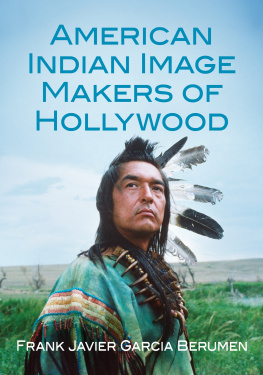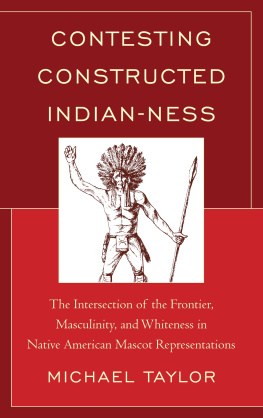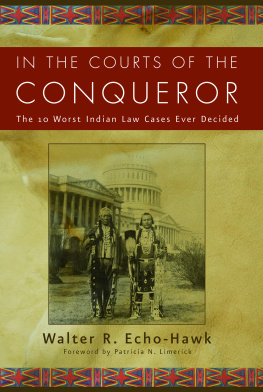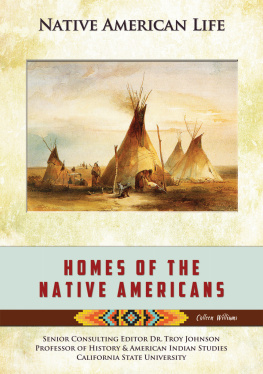
Also by
FRANK JAVIER GARCIA BERUMEN
Latino Image Makers in Hollywood: Performers, Filmmakers and Films Since the 1960s (McFarland, 2014)
American Indian Image Makers of Hollywood
FRANK JAVIER GARCIA BERUMEN

McFarland & Company, Inc., Publishers
Jefferson, North Carolina
LIBRARY OF CONGRESS CATALOGUING DATA ARE AVAILABLE
BRITISH LIBRARY CATALOGUING DATA ARE AVAILABLE
e-ISBN: 978-1-4766-3647-4
2020 Frank Javier Garcia Berumen. All rights reserved
No part of this book may be reproduced or transmitted in any form or by any means, electronic or mechanical, including photocopying or recording, or by any information storage and retrieval system, without permission in writing from the publisher.
Front cover image of Graham Greene in Dances with Wolves, 1990 (Orion Pictures Corporation/Photofest)
McFarland & Company, Inc., Publishers
Box 611, Jefferson, North Carolina 28640
www.mcfarlandpub.com
For:
My mother, who from childhood educated me about our Huichol roots, traveled with me to numerous preColumbian sites, and informed me about the numerous achievements and cultures of indigenous America.
My native ancestors and their legacy of respecting Mother Earth, honoring the Great Spirit, and being grateful for every gift, in every stage in the circle of life.
The Native American activists of the 1970s, who led us out of the recesses of oblivion and into a rediscovery of ourselves.
Rita Padmore, a dear colleague and friend, whose support in one of my darkest hours blessed me with her support and friendship.
Leonard Noriega, a close friend in the journey of life, who walked on from the road too soon.
Before 1492, tens of millions of Native Americans lived in the Americas, from the north to the furthermost south. Over the course of some five hundred years, most of their collective history has been destroyed, mislaid, or marginalized.
We stand on the shoulders of our ancestors, and we must speak on their behalf to tell their stories through oral history, literature and film. To remember is to relive, and to relive is to reconnect to the tree of life and to history.
Introduction
The primary purpose of this book is to document the history of Native American film images and filmmakers in U.S. motion pictures, from the late 1800s to the present. A secondary purpose is to celebrate the contributions of Native Americans in U.S. cinema.
I have carried this book inside me since my childhood, when I watched my first motion picture. From the beginning I knew that these film images were at odds with my history and culture. And the more I learned about my history and culture, the more I became aware of the great divide between the dominant white culture and the native culture.
The writing of this book has been a journey of rediscovering the lives and accomplishments of many native people. Through my extensive research, I became aware of the thousands of Native Americans in the film industry who have contributed anonymously, devoid of awards or wealth, and of the hundreds of historical events in Native American history and stories that have never reached the screen.
The arrival of Europeans in the Americas had (and continues to have) an incalculable impact on the lives of all native peoples throughout the Americas: economically, socially, politically, and culturally. Many tribes became extinct (like the Tano in the Caribbean islands), and others were substantially reduced in numbers. Numerous languages and traditions that had survived for thousands of years were obliterated. The massive and forced movement of millions of native peoples from and to reservations resulted in cultural disorientation. The rape and violation of native women created the mestizo and other ethnic mixtures. Military-like boarding schools, Christian schools, and the public schools of nation-states forcefully assimilated millions of native children. They were robbed of their culture, language, religion, dress, and self-identity. For some, a deep-rooted sense of inferiority, denial, and self-hatred became ingrained in their psyches.
Miraculously, many native peoples, against almost insurmountable odds, clung to and maintained their respective cultures: oral history, traditions, language, religion, and self-identity. The rest became lost and marginalized in the evolution and formalization of nation-states. In the United States, the federal government determined who was indigenous and who was notwhat tribes were recognized as First Nations and which were not. In the rest of the Americas, different ways were formulated in order to dilute the presence of native peoples in individual countries. For instance, Mexico continues to have the largest native population in the Americas; however, even Mexicos government has developed revisionist demographics.
Movies have exercised a powerful influence on how Native Americans have been viewed. The film images have obliterated both the truth and the history. In the 1962 John Ford film The Man Who Shot Liberty Valance, there is a phrase that expresses the revisionism of U.S. history. In one scene, a politician asks a reporter whether he plans to print the truth. The reporter responds, When the legend becomes fact, print the legend! This statement summarizes the written and cinematic history of the nation. For more than one hundred years, movies have been perpetuating myths and legends about Native Americans.
Many U.S. films have represented Native American genocide as entertainment. The film image of native people as savagesbloodthirsty, cruel, and uncivilizedis an indelible one. Thousands of films have depicted them as an impediment to progress and civilization. Conversely, Europeans and Euro-Americans have always been portrayed on film as perpetual victims rather than invaders or perpetrators. Films have depicted stagecoach and railroad passengers, covered wagon pioneers, and besieged U.S. Cavalry units shooting down hundreds upon hundreds of screaming indigenous warriors as a sporting entertainment. U.S. films have recycled and glorified macho white men as professional Indian fighters (another name for Native American exterminators). No other ethnicity has had this genocidal term created for them. Native women have fared no better, being inevitably portrayed as scheming and treacherous, promiscuous, and objects of ridicule. According to these movies, native women are always lusting for the stalwart white protagonist, even at the expense of their own people.
The vast majority of these indigenous characters, until recently, have been portrayed by white performers. Euro-American performers were smeared with brown grease to darken their appearance, and they spoke a bizarre series of invented languages. The Hollywood film industry created a one-size-fits-all type of native attire, pseudo-rituals, and psychopathic cultural traits. None of the Euro-American film characters could ever understand why native peoples were resisting their home invasion, diseases, and extermination. Movies are entertainment, but they are also a mirror of how a society wishes to see itself. In addition, films are artifacts of anthropology, for they reveal what a society believes, how it behaves, and what it chooses to remember to (or to forget).
Popular culture has often perpetuated the worst of societys prejudices and mores. The first images of native peoples were born at the moment when Europeans landed on the continent and saw the indigenous residents as darker, different, and exotic. The diaries, ships logs, and reports that these Europeans conveyed to their brethren across the ocean became the first stereotypes and images of native peoples. Later, the official documents of genocide and conquest chronicled the justification (i.e., paganism, uncivilized, etc.) of the misdeeds committed by the Spanish, Portuguese, French, English, and other invaders and conquerors. These images were in turn immortalized in church documents, colonial correspondence, government archives, newspapers, novels, Wild West shows, and plays. At the end of the 1800s, these stereotypes and derogatory images were transplanted into the infant art of cinema.
Next page








